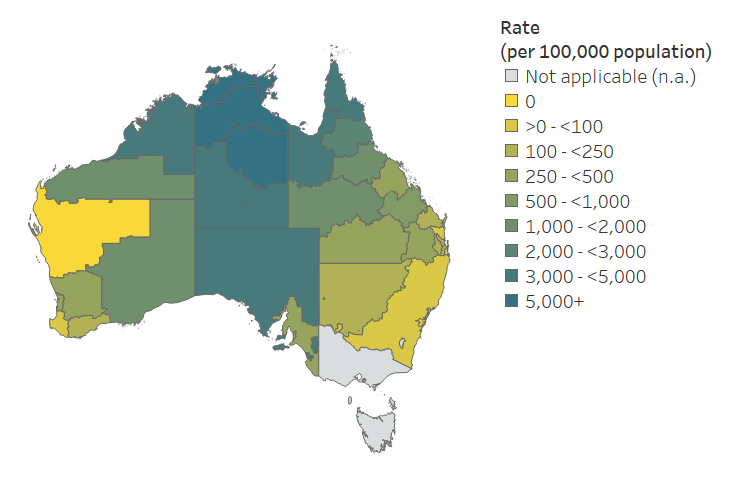Management of acute rheumatic fever and rheumatic heart disease
At 31 December 2022, there were 10,349 people on the rheumatic heart disease (RHD) registers living with a diagnosis of acute rheumatic fever (ARF) and/or RHD in New South Wales, Queensland, Western Australia, South Australia, and the Northern Territory. Of these:
- 31% people had ARF only recorded, 30% had only RHD recorded, and 38% had both ARF and RHD recorded (Supplementary table 5.1)
- the Northern Territory had the highest number of people living with ARF and/or RHD, followed by Queensland, Western Australia, South Australia, and New South Wales (Supplementary table 5.2)
- First Nations people accounted for 82% (8,448) of the diagnoses (Supplementary table 5.2)
- more females than males were living with a diagnosis of ARF and/or RHD (Supplementary table 5.3).
- the rate of people being managed for ARF and/or RHD increased as remoteness increased (Supplementary table 5.5).
The region of management is recorded for everyone reported to the register. This is the region where the health service which is responsible for the coordination of their primary health care for ARF or RHD is located. The region of management may differ from where they were diagnosed with or developed ARF or RHD. The regions with the highest rates of management for First Nations people were:
- Rural Darwin (NT), with 7,859 cases per 100,000 population
- Barkly (NT), with 6,636 per 100,000
- East Arnhem (NT), with 6,488 per 100,000 (Figure 5.1; Supplementary table 5.4).
Figure 5.1: ARF and/or RHD diagnoses among First Nations people, by region of management, at 31 December 2022

Source: AIHW analysis of National Rheumatic Heart Disease Data Collection.
Notes
- Crude rates (per 100,000 population) are calculated using the number of diagnoses, divided by the regional population. The state or territory totals are from the Australian Bureau of Statistics (ABS). The remoteness populations from NSW and SA are derived from ABS data. The other regional populations are provided by each state or territory. Due to constraints in the jurisdictions, previous populations were used when new populations were unable to be supplied. Qld uses 2020 data as a proxy. WA uses 2021 data as a proxy. NT is up to date.
- Includes all First Nations people managed for ARF and/or RHD in 2022.
- The data excludes any ARF and/or RHD diagnoses nationally that had an unknown or other region of management.


